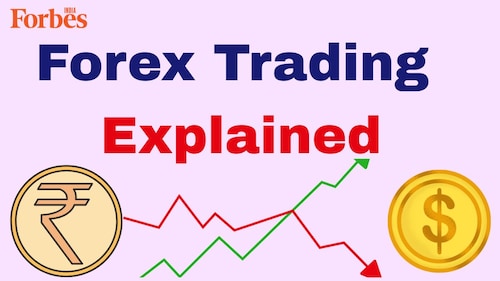Forex trading explained: How it works, its types, and more
Understand everything about the forex trading platform and how it works. Know which strategies to employ and navigate the market effectively


Forex trading is not new it traces back to trading in ancient Egypt. Short for foreign exchange, forex is the backbone of the global financial system. With an average daily trading volume of $7.5 trillion in 2022 (Bank for International Settlements Triennial Survey report), the forex market is the world"s largest and most liquid financial market. The market showed 14 percent growth from its previous $6 trillion-plus valuation in 2019. Another recent report by the New York Foreign Exchange Committee (October 2024) mentioned that over-the-counter (OTC) forex trading valuation reached around $1,196 billion per day, including spot trading, swaps, and options.
In India, SEBI-regulated forex trading platforms offer legal access to currency derivatives. While direct trading in foreign currency pairs is restricted, Indian traders can participate through authorised brokers and regulated avenues.
So, why is forex trading so popular? In this post, we’ll discuss forex trading, how it works, the types, and some of the challenges involved, which will help you better understand the market.
Forex is a marketplace for purchasing and selling currencies that operates without a central exchange, making it the most reliable financial market globally. The forex market relies on currency price fluctuations, allowing traders to profit from exchange rate movements. Its 24-hour trading cycle makes it appealing to various levels of investors, businesses, and institutions.
With benefits like hedging, high liquidity, leverage, and market accessibility, forex offers endless opportunities to capitalise on the evolving currency landscape.
Forex trading in India operates through recognised banks, brokers, and financial institutions like the RBI (Reserve Bank of India) and SEBI (Securities and Exchange Board of India). Unlike platforms like the National Stock Exchange (NSE) or the Bombay Stock Exchange (BSE), forex transactions take place over the counter. This means they occur directly between parties across different time zones. They operate 24/5 across major financial hubs like London, New York, and Tokyo, allowing traders to speculate on currency shifts at any hour.
Currency pairs: Each currency has a three-letter code—USD (US Dollar), EUR (Euro), GBP (British Pound), CAD (Canadian Dollar), JPY (Japanese Yen), and more—and is always traded in pairs.
Spreads: The difference between a bid (buy price) and an ask (sell price) is called the spread. The market price must move beyond this spread in your favour to profit.
Leverage: It allows traders to handle larger positions with a smaller initial capital. This can significantly amplify potential profits but also increase risk.
Forex trading is split into a few different types:
Forex trading platforms offer a variety of strategies to suit your trading styles and goals:
Though forex markets are good for profits, you should also remember that they carry certain inherent risks—high market volatility, market sentiments, leverage risks, regulatory issues, liquidity issues, and sometimes fraud. Currency pairs with lower trading volumes may lead to slippage, making executing trades at desired prices difficult.
Understanding these risks and hedging will help you make mindful decisions when using a forex trading platform.
India’s forex market is growing steadily—its market size was valued at $30 billion-plus in 2024. According to IMARC Group, this value should reach nearly $66 billion by 2033, with a growth rate of 8.8 perecnt. This growth is due to the rise in remittances from NRIs and increasing foreign investments, especially in IT and business services.
The market potential is immense, and if you’re new to the field, starting forex trading in India is simple:
1. Can I open a forex account in India?
Yes, you can. To open a forex trading account in India, choose a broker registered with SEBI for a safe trading experience.
2. What are the permitted forex derivative products?
In India, on authorised platforms, forex trading is restricted to currency pairs like USD/INR, GBP/INR, JPY/INR, and EUR/INR.
3. What is the 5-3-1 rule in Forex?
The 5-3-1 strategy refers to five currency pairs to focus on, three trading strategies, and one specific time to trade. The main goal is maintaining consistency, reducing risks, and maximising returns.
First Published: Apr 23, 2025, 16:01
Subscribe Now